A Study on the Viability of Adopting Battery Electric Vehicles in Bus Rapid Transit in Brazil Using the AHP Method
Abstract
1. Introduction
2. Background
2.1. Electric Buses
2.2. Bus Rapid Transit—BRT
3. Materials and Methods
- Economic impact: To build the economic impact factor, we used the sub-criteria of vehicle acquisition (cost/estimated years of use), energy cost (energy per kilometer traveled—tank-to-wheel (TTW)) and maintenance (cost of maintenance per kilometer traveled).
- Environmental impact: To build the environmental impact factor, the following criteria were considered: air pollution (USD per passenger per km), noise pollution (qualitative value based on the literature), and energy production (cleanliness of production energy matrix of country—well-to-tank (WTT)).
- Social impact: To build the social impact factor, we considered discomfort (on the trip—qualitative value based on the literature), unsafe conditions (qualitative value based on the literature), and population health (qualitative value based on the literature).
- Vehicle acquisition: The vehicle acquisition cost is currently higher for an electric bus (USD 682,000.00 using the BYD D11B as a basis [56]) than for a diesel bus (USD 359,000.00 using the Mercedes-Benz O-500 UDA—BlueTec 5 as a basis) [57]. However, an electric model has a longer duration of use, estimated to be 15 years, compared to a diesel vehicle which has 10 years [58]. For this reason, to equalize the cost, it was decided to compare the purchase price divided by the useful life of the vehicle, which resulted in USD 46,000.00 for an electric bus and USD 36,000.00 for a diesel bus.
- Energy cost: The energy cost for vehicle operation was calculated for an electric bus considering the value of kWh is USD 0.13 [59] and an electric bus has a consumption of 1.26 kWh/km [38], resulting in USD 0.16/km plus 13% for air conditioning operation for a total of USD 0.19/km, with an overnight battery recharge. For a diesel bus, the average cost of diesel was calculated to be USD 1.14 [60] and consumption was calculated to be 0.15 l/km, resulting in the value of USD 0.85/km; by adding 13% for the consumption for air conditioning, a total cost of USD 0.96/km was calculated for implementing the Arla 32 system to reduce emissions [61].
- Air pollution: In terms of emissions into the air, electric vehicles have an advantage over diesel vehicles as they do not emit gases. The emissions from an articulated bus was calculated considering the value of the impact of smoke in a metropolitan area—EUR 0.0116 converting to USD 0.01200/passenger/km. Considering an articulated bus with a capacity of 170 passengers (22 m for electric buses and 23 for diesel ones) running at its maximum capacity, we reached the value of USD 216,000.00, which is very close to the operating cost of the vehicle [62].
- Noise pollution: For monitoring noise pollution, the evaluation was qualitative, according to Raymundo and Reis [62]. The noise generated by vehicle operation creates effects on sound waves and is well known in the literature, but it is not easy to measure outside a laboratory. In this way, it was considered that an electric bus has an impact between moderate and strong, and we assigned an index of 4 according to Table 2. Noise causes well-being and social disturbances that can be psychological and emotional, such as displeasure, sleep disturbances, and loss of productivity, and physiological disturbances, such as hearing damage and fatigue [62].
- Energy production: Regarding the energy production requirement, the impact of energy generation due to vehicle movement was evaluated. An electric bus is considered in the Brazilian electrical matrix to be predominantly clean, with 82.9% of energy extracted from renewable sources, most of them through hydroelectric plants (56.8%) [63].
- Discomfort: The disutilities of transport were not socially evaluated; in a qualitative way, they reflect the preservation of the use of a transport system, and in the case of this study, the bus model [62]. The first disutility is discomfort, which is the disutility related to what bothers passengers during transport, such as an earlier injury or abortion, allowing the consideration of how physical or psychological discomfort can be limited.
- Unsafe conditions: the second disutility is unsafe conditions, which is the disutility of transporting passengers that are related to the safety of using the mode of transport under study, and the causes can be human, vehicle, and infrastructure deficiencies in addition to the risk of traffic accidents [62].
- Population health: the health of the population is an externality related to the negative impacts on society associated with transport infrastructure to the detriment of other land uses [63].
| n | 1 | 2 | 3 | 4 | 5 | 6 | 7 | 8 | 9 |
| RI | 0.0 | 0.0 | 0.58 | 0.90 | 1.12 | 1.24 | 1.32 | 1.41 | 1.45 |
4. Results
5. Discussion
6. Conclusions
Author Contributions
Funding
Data Availability Statement
Conflicts of Interest
References
- Carvalho, C.H. Urban Development. Available online: https://www.worldbank.org/en/topic/urbandevelopment/overview (accessed on 5 May 2023).
- Kębłowski, W.; Dobruszkes, F.; Boussauw, K. Moving past sustainable transport studies: Towards a critical perspective on urban transport. Transp. Res. Part A Policy Pract. 2022, 159, 74–83. [Google Scholar] [CrossRef]
- Tucki, K.; Orynycz, O.; Wasiak, A.; Świć, A.; Mruk, R.; Botwińska, K. Estimation of Carbon Dioxide Emissions from a Diesel Engine Powered by Lignocellulose Derived Fuel for Better Management of Fuel Production. Energies 2020, 13, 561. [Google Scholar] [CrossRef]
- OECD. Financing Climate Objectives in Cities and Regions to Deliver Sustainable and Inclusive Growth; OECD Environment Policy Papers: Paris, France, 2019; p. 17. [Google Scholar] [CrossRef]
- Vicente, P.; Sampaio, A.; Reis, E. Factors influencing passenger loyalty towards public transport services: Does public transport providers’ commitment to environmental sustainability matter? Case Stud. Transp. Policy 2020, 8, 627–638. [Google Scholar] [CrossRef]
- Cruz, I.S.; Katz-Gerro, T. Urban public transport companies and strategies to promote sustainable consumption practices. J. Clean. Prod. 2016, 123, 28–33. [Google Scholar] [CrossRef]
- UITP. Metro. Available online: https://www.uitp.org/topics/metro/ (accessed on 8 May 2023).
- Kerkhof, A. Bus. Available online: https://www.uitp.org/topics/bus/ (accessed on 5 May 2023).
- UITP. Electric and Innovative BRT for Green Cities: UITP Coordinates eBRT2030 as New Flagship Project on Electric Mobility. Available online: https://www.uitp.org/news/electric-and-innovative-brt-for-green-cities-uitp-coordinates-ebrt2030-as-new-flagship-project-on-electric-mobility/ (accessed on 8 May 2023).
- Amicci, A.G.N.; Fernandes, A.; Malburg, C.H.R.; Santos, D.V.; Araldi, F.; Souza, F.d.O.; Di Pierro, L.F.; Nakazaki, M.; Silva, N.A.A.d.; Santana, O.; et al. Guia TPC: Orientações Para Seleção de Tecnologias e Implementação de Projetos de Transporte Público Coletivo. Technical Report, BNDES. 2018. Available online: https://web.bndes.gov.br/bib/jspui/handle/1408/14921 (accessed on 8 May 2023).
- Institute for Transportation and Development Policy—ITDP. The BRT Standard; ITDP: Rio de Janeiro, Brazil, 2016. [Google Scholar]
- Lindau, L.A.; Senna, L.A.D.S.; Strambi, O.; Martins, W.C. Alternative financing for Bus Rapid Transit (BRT): The case of Porto Alegre, Brazil. Res. Transp. Econ. 2008, 22, 54–60. [Google Scholar] [CrossRef]
- Hidalgo, D.; Gutiérrez, L. BRT and BHLS around the world: Explosive growth, large positive impacts and many issues outstanding. Res. Transp. Econ. 2013, 39, 8–13. [Google Scholar] [CrossRef]
- Nikitas, A.; Karlsson, M. A Worldwide State-of-the-Art Analysis for Bus Rapid Transit: Looking for the Success Formula. J. Public Transp. 2015, 18, 1–33. [Google Scholar] [CrossRef]
- Shyr, O.F.; Andersson, D.E.; Cheng, Y.-H.; Hsiao, Y.-H. What explains rapid transit use? Evidence from 97 urbanized areas. Transp. Res. Part A Policy Pract. 2017, 100, 162–169. [Google Scholar] [CrossRef]
- Krelling, C.; Badami, M.G. Operational and financial performance of Delhi’s natural gas-fueled public bus transit fleet: A critical evaluation. Transp. Policy 2016, 47, 178–188. [Google Scholar] [CrossRef]
- Mahdavi, S.M.H.; Bhouri, N.; Scemama, G. Dynamic Resilience of Public Transport Network: A Case Study for Fleet-Failure in Bus Transport Operation of New Delhi. Transp. Res. Procedia 2020, 47, 672–679. [Google Scholar] [CrossRef]
- Goedeking, N. What political institutions support Bus Rapid Transit? Evidence from a survival analysis of 92 cities in low- and middle-income countries. Energy Res. Soc. Sci. 2023, 100, 103084. [Google Scholar] [CrossRef]
- Attard, M. Planning for Bus Rapid Transit in an island context. The challenges of implementing BRT in Malta. Res. Transp. Econ. 2023, 100, 101309. [Google Scholar] [CrossRef]
- Samerei, A.; Aghabayk, K.; Soltani, A. Occupational Health and Job Satisfaction Assessment of Bus Rapid Transit (BRT) Drivers. J. Public Transp. 2022, 24, 100002. [Google Scholar] [CrossRef]
- Dzikuć, M.; Miśko, R.; Szufa, S. Modernization of the Public Transport Bus Fleet in the Context of Low-Carbon Development in Poland. Energies 2021, 14, 3295. [Google Scholar] [CrossRef]
- BRT Appreciated Worldwide. What Does This Mean for Wrocław? Available online: https://www.transport-publiczny.pl/wiadomosci/brt-doceniane-na-swiecie-co-to-oznacza-dla-wroclawia-47255.html (accessed on 1 June 2023).
- Metrobus—A Great Opportunity or a Way to Get Rid of Trams? Available online: https://www.transport-publiczny.pl/wiadomosci/metrobus--wielka-szansa-czy-sposob-na-pozbycie-sie-tramwajow-2528.html (accessed on 1 June 2023).
- A City Where BRT Ends in Failure. Available online: https://www.transport-publiczny.pl/wiadomosci/miasto-w-ktorym-brt-konczy-sie-fiaskiem-53948.html (accessed on 1 June 2023).
- Volvo Bus Rapid Transit. Available online: https://www.volvobuses.com/pl/city-and-intercity/innovation/bus-rapid-transit.html (accessed on 1 June 2023).
- Levinson, T.C.H.S.; Zimmerman, D.S.; Clinger, D.J.; Rutherford, H.S.C. Bus Rapid Transit: An Overview. J. Public Transp. 2002, 5, 1–30. [Google Scholar] [CrossRef]
- EMT Madrid Launches a BRT. 10 Irizar ie Tram on a Line with Traffic Light Priority. Available online: https://www.sustainable-bus.com/news/emt-madrid-brt-line-irizar/ (accessed on 1 June 2023).
- Solaris to Supply 14 Double Articulated Electric Buses to Tide Bus Danmark. Available online: https://www.solarisbus.com/pl/biuro-prasowe-solaris-bus-coach-sp-z-o-o/solaris-dostarczy-14-dwuprzegubowych-autobusow-elektrycznych-do-tide-bus-danmark-1649 (accessed on 1 June 2023).
- Hydrogen Buses Base BRT in Pau. Available online: https://transinfo.pl/infobus/wodorowe-autobusy-podstawa-brt-w-pau-_more_120123/ (accessed on 1 June 2023).
- Citea Slfa Electric Brt. Available online: https://www.vdlbuscoach.com/pl/produkty/citea/citea-slf-slfa-electric (accessed on 1 June 2023).
- VDL Delivers a Citea Electric to Postbus Switzerland. Go with the Electric Pilot! Available online: https://www.sustainable-bus.com/news/vdl-bus-coach-electric-pilot-electric-bus-to-postbus-switzerland/ (accessed on 1 June 2023).
- OECD. Cities and Climate Change: National Governments Enabling Local Action; OECD: Paris, France, 2014; Available online: https://www.oecd.org/env/cc/Cities-and-climate-change-2014-Policy-Perspectives-Final-web.pdf (accessed on 5 May 2023).
- Ferreira, E.R. Trólebus, Espaço e Sociedade. Ph.D.Thesis, Universidade de São Paulo, São Carlos, Brazil, 1995. [Google Scholar] [CrossRef]
- Zaparolli, D. Electric Buses on the Horizon. Available online: https://www.ipea.gov.br/portal/index.php?option=com_content&view=article&id=9567 (accessed on 4 April 2023).
- São Paulo Transporte S/A—SPTrans. Relatorio de Administracao 2018; São Paulo Transporte S/A—SPTrans: São Paulo, Brazil, 2018; p. 477. [Google Scholar]
- De França, R.; Fleury, A.d.T. Implementation of buses with greater energy efficiency as an evolution for public transport in the city of São Paulo. Rev. IPT Tecnol. Inovação 2023, 7, 7–26. [Google Scholar]
- Macedo, J.E.J. Estudo de Linha de Trólebus em Natal. Ph.D. Thesis, Universidade Federal do Rio Grande do Norte, Natal, Brazil, 2017. [Google Scholar]
- NTU. Centro de Documentação e Memória Eurico Divon Galhardi, 1st ed.; Associação Nacional das Empresas de Transportes Urbanos—NTU: Brasília, Brazil, 2019. [Google Scholar]
- Vaz, L.F.H.; Barros, D.C.; Castro, B.H.R.d. Veículos híbridos e elétricos: Sugestões de políticas públicas para o segmento. BNDES Set. 2015, 41, 295–344. [Google Scholar]
- Summit Mobilidade. Em Shenzhen, na China, 100% dos Ônibus e Táxis São Elétricos. Available online: https://summitmobilidade.estadao.com.br/ir-e-vir-no-mundo/em-shenzhen-na-china-100-dos-onibus-e-taxis-sao-eletricos/ (accessed on 6 November 2022).
- Radar, E. Relatório Ebus Radar. Available online: http://lookerstudio.google.com/reporting/2884db9f-149e-41de-b13f-1e55ad434335/page/gr8lB?feature=opengraph (accessed on 1 November 2022).
- Ministério das Cidades. Manual de BRT (Bus Rapid Transit) Guia de Planejamento; Ministério das Cidades: Brasília, Brazil, 2008.
- Harrington; Kelker; Leuw, D. Transit Plans—1937 Plan. Available online: https://www.chicago-l.org/plans/1937plan.html (accessed on 1 July 2022).
- McQueen, J.T.; Waksman, R. Increasing the People-Moving Capability of Shirley Highway. Available online: https://onlinepubs.trb.org/Onlinepubs/trr/1977/626/626-006.pdf (accessed on 31 May 2023).
- Lesley, L. Runcorn A Rapid Transit New Town? Built Environ. 1983, 9, 232–244. [Google Scholar]
- Mejía-Dugand, S.; Hjelm, O.; Baas, L.; Ríos, R.A. Lessons from the spread of Bus Rapid Transit in Latin America. J. Clean. Prod. 2013, 50, 82–90. [Google Scholar] [CrossRef]
- Cottrell, W.D. Transforming a Bus Station into a Transit-Oriented Development: Improving Pedestrian, Bicycling, and Transit Connections. Transp. Res. Rec. J. Transp. Res. Board 2007, 2006, 114–121. [Google Scholar] [CrossRef]
- Vasconcellos, E.A.; Mendonça, A. Política nacional de transporte público no Brasil: Organização e implantação de corredores de ônibus. Rev. Transp. Públicos ANTP 2010, 33, 73–95. [Google Scholar]
- Lopez, R. El Corredor de Trolebuses de Quito. Carret. Rev. Técnica Asoc. Española Carret. 2003, 133, 99–115. [Google Scholar]
- TransMilenio. Estadísticas de Oferta y Demanda del Sistema Integrado de Transporte Público SITP. Available online: https://www.transmilenio.gov.co/publicaciones/149180/estadisticas-de-oferta-y-demanda-del-sistema-integrado-de-transporte-publico-sitp/ (accessed on 1 July 2022).
- Global BRT Data. Available online: https://brtdata.org/ (accessed on 12 April 2023).
- Saaty, T.L. Decision making with the analytic hierarchy process. Int. J. Serv. Sci. 2008, 1, 83–98. [Google Scholar] [CrossRef]
- Wolff, C.S. O Método AHP: Revisão Conceitual e Proposta de Simplificação. Master’s Thesis, PUC Rio de Janeiro, Rio de Janeiro, Brazil, 2008. [Google Scholar]
- Peinado, H. Método AHP Para Tomada de Decisão Multicritério; Number 103 in Coleção Fundamentum; EDUEM: Maringá, Brazil, 2016. [Google Scholar]
- Lucena, A.F.E.; Mori, L.M.D. Uso do Analytic Hierarchy Process (AHP) para Hierarquização de Métodos de Mensuração do Grau de Aplicação da Construção Enxuta. Rev. Gestão Ind. 2018, 14, 48–69. [Google Scholar] [CrossRef]
- Campo Grande, P. BYD D11B: Dirigimos o Ônibus Elétrico de 22 m Fabricado no Brasil. Available online: https://quatrorodas.abril.com.br/carros-eletricos/byd-d11b-dirigimos-o-onibus-eletrico-de22-m-fabricado-no-brasil/ (accessed on 12 April 2023).
- Ferreira, M. Teste: Dirigimos um Ônibus Superarticulado da Mercedes-Benz e não Pagamos a Passagem | Ônibus e Caminhões | Autoesporte. Available online: https://autoesporte.globo.com/testes/review/2021/03/teste-dirigimos-um-onibus-superarticulado-da-mercedes-benz-e-nao-pagamos-a-passagem.ghtml (accessed on 12 April 2023).
- Rebouças, A.B.; Daniel, J. Análise Operacional de Ônibus Elétricos a Bateria em São Paulo. Available online: https://theicct.org/wp-content/uploads/2022/11/brazil-hvs-ZEBRA-analise-operacion-onibus-eletricos-Sao-Paulo-nov22-1.pdf (accessed on 12 May 2023).
- Enel. Enel Brasil. Available online: https://enel.com.br/content/enel-br/pt-saopaulo.html (accessed on 12 April 2023).
- Agência Nacional de Petróleo—ANP. Preços de Revenda e de Distribuição de Combustíveis. Available online: https://www.gov.br/anp/pt-br/assuntos/precos-e-defesa-da-concorrencia/precos/precos-revenda-e-de-distribuicao-combustiveis/levantamento-de-precos-de-combustiveis (accessed on 12 April 2023).
- Edital Completo da Prestação e Exploração do Serviço de Transporte Coletivo Público de Passageiros na Capital. Available online: http://www.antp.org.br/noticias/clippings/edital-completo-da-prestacao-e-exploracao-do-servico-de-transporte-coletivo-publico-de-passageiros-na-capital.html (accessed on 21 June 2023).
- Raymundo, H.; Reis, J.G.M. How to Measure Performance Evaluation in Urban Passenger Transportation by Disutilities: Model and Application in the Ten Largest US Cities. J. Urban Plan. Dev. 2023, 149, 04023007. [Google Scholar] [CrossRef]
- Empresa de Pesquisa Energética—EPE. Matriz Energética. Available online: https://www.epe.gov.br/pt/abcdenergia/matriz-energetica-e-eletrica (accessed on 12 April 2023).
- Ishizaka, A.; Labib, A. Analytical hierarchy process and expert choice: Benefits and limitations. Oper. Res. Insight 2009, 22, 201–220. [Google Scholar] [CrossRef]
- Bagheri, M.; Lonik, K.A.T.; Jaafar, M.; Adam, R.; Talaat, W.I.A.W.; Wolf, I.D. Integrating Social, Economic, and Environmental Factors to Evaluate How Competitive Urban Landscapes Are for the Development of Sustainable Cities: Penang Island in Malaysia as a Case Study. Land 2023, 12, 104. [Google Scholar] [CrossRef]
- Xu, L.; Kumar, D.T.; Shankar, K.M.; Kannan, D.; Chen, G. Analyzing criteria and sub-criteria for the corporate social responsibility-based supplier selection process using AHP. Int. J. Adv. Manuf. Technol. 2013, 68, 907–916. [Google Scholar] [CrossRef]
- de Araújo, F.A.; dos Reis, J.G.M.; da Silva, M.T.; Aktas, E. A Fuzzy Analytic Hierarchy Process Model to Evaluate Logistics Service Expectations and Delivery Methods in Last-Mile Delivery in Brazil. Sustainability 2022, 14, 5753. [Google Scholar] [CrossRef]
- Carvalho, C.H.R.d. Mobilidade Urbana Sustentável: Conceitos, Tendências e Reflexões; Instituto de Pesquisa Econômica Aplicada: Rio de Janeiro, Brazil, 2016.
- Machado, N. Enel X Estuda Eletrificação de Frotas de Ônibus em Cidades Brasileiras. Available online: https://epbr.com.br/enel-x-estuda-eletrificacao-de-frotas-de-onibus-em-cidades-brasileiras/ (accessed on 12 April 2023).
- Rodrigues, G.S.; dos Reis, J.G.M.; Machado, S.T. Panorama da mobilidade elétrica no transporte público da Região Metropolitana de São Paulo—Brasil. In Proceedings of the VII Congresso Internacional de Logística e Operações do IFSP—Suzano; IFSP: Suzano, Brazil, 2021; Volume 1. [Google Scholar]
- Barassa, E.; Cruz, R.F.d.; Moraes, H.B. 1° Anuário Brasileiro da Mobilidade Elétrica; Plataforma Nacional da Mobilidade Elétrica: Rio de Janeiro, Brazil, 2020. [Google Scholar]
- Hanson, S. Introducing Urban Transportation. In The Geography of Urban Transportation, 4th ed.; Giuliano, G., Hanson, S., Eds.; Guilford Press: New York, NY, USA, 2017; pp. 15–57. [Google Scholar]
- Yang, Y.; Han, X.; Jiang, R.; Jia, B.; Gao, Z.-Y. Competition and coordination in public transport: A mode choice experiment. Transp. Res. Part C Emerg. Technol. 2022, 143, 103858. [Google Scholar] [CrossRef]
- Raymundo, H.; Reis, J.G.M.d. Measures for Passenger-Transport Performance Evaluation in Urban Areas. J. Urban Plan. Dev. 2018, 144, 04018023. [Google Scholar] [CrossRef]
- Williams, R.V.; Excell, P. Crossrail—London’s new underground railway. In Proceedings of the 2018 25th International Workshop on Electric Drives: Optimization in Control of Electric Drives (IWED), Moscow, Russia, 31 January–2 February 2018; pp. 1–9. [Google Scholar] [CrossRef]
- Dallmann, T. Benefícios de Tecnologias de Ônibus em Termos de Emissões de Poluentes do ar e do Clima em São Paulo; Technical Report; International Council of Clean Transportation: Washington, DC, USA, 2019; p. 572. [Google Scholar]
- UITP. Transforming Cities with Bus Rapid Transit (BRT) Systems: How to Integrate BRT? Technical Report; UITP: Brussels, Belgium, 2019. [Google Scholar]
- Sousa, M.S. José dos Campos (SP) Assume o Transporte e Anuncia Frota Elétrica. Available online: http://www.mobilize.org.br/noticias/13061/s-jose-dos-campos-sp-assume-o-transporte-e-%20576%20anuncia-frota-eletrica.html (accessed on 31 May 2023).
- Albuquerque, C.; Tavares, V.; Siqueira, E.; Corrêa, F. Ônibus Elétricos: Um Guia de Eletromobilidade Para Cidades Brasileiras. Available online: https://www.wribrasil.org.br/noticias/como-implementar-onibus-eletricos-um-guia-de-eletromobilidade-para-cidades-brasileiras (accessed on 31 May 2023).
- Mavi, R.K.; Zarbakhshnia, N.; Khazraei, A. Bus rapid transit (BRT): A simulation and multi criteria decision making (MCDM) approach. Transp. Policy 2018, 72, 187–197. [Google Scholar] [CrossRef]

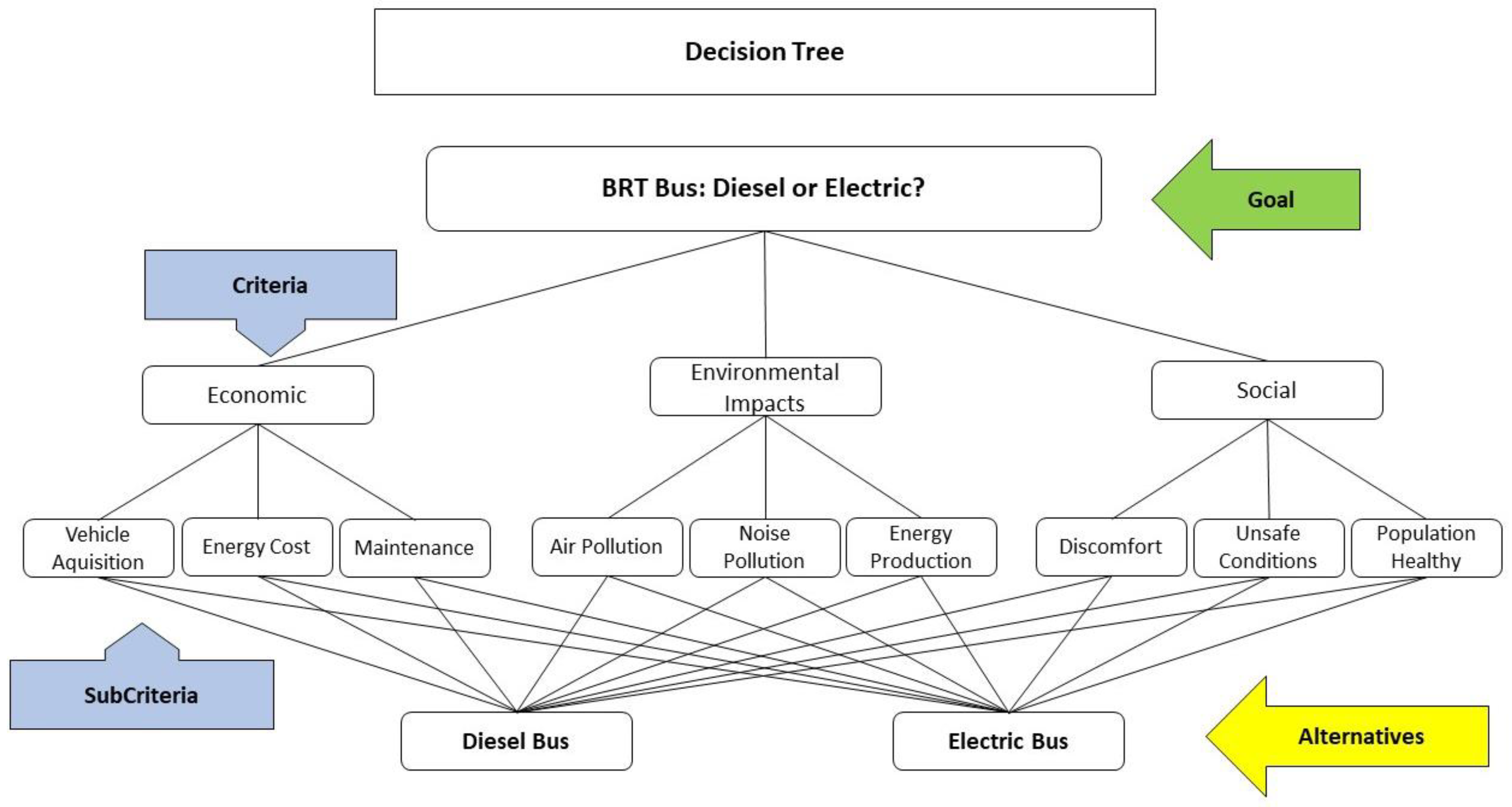
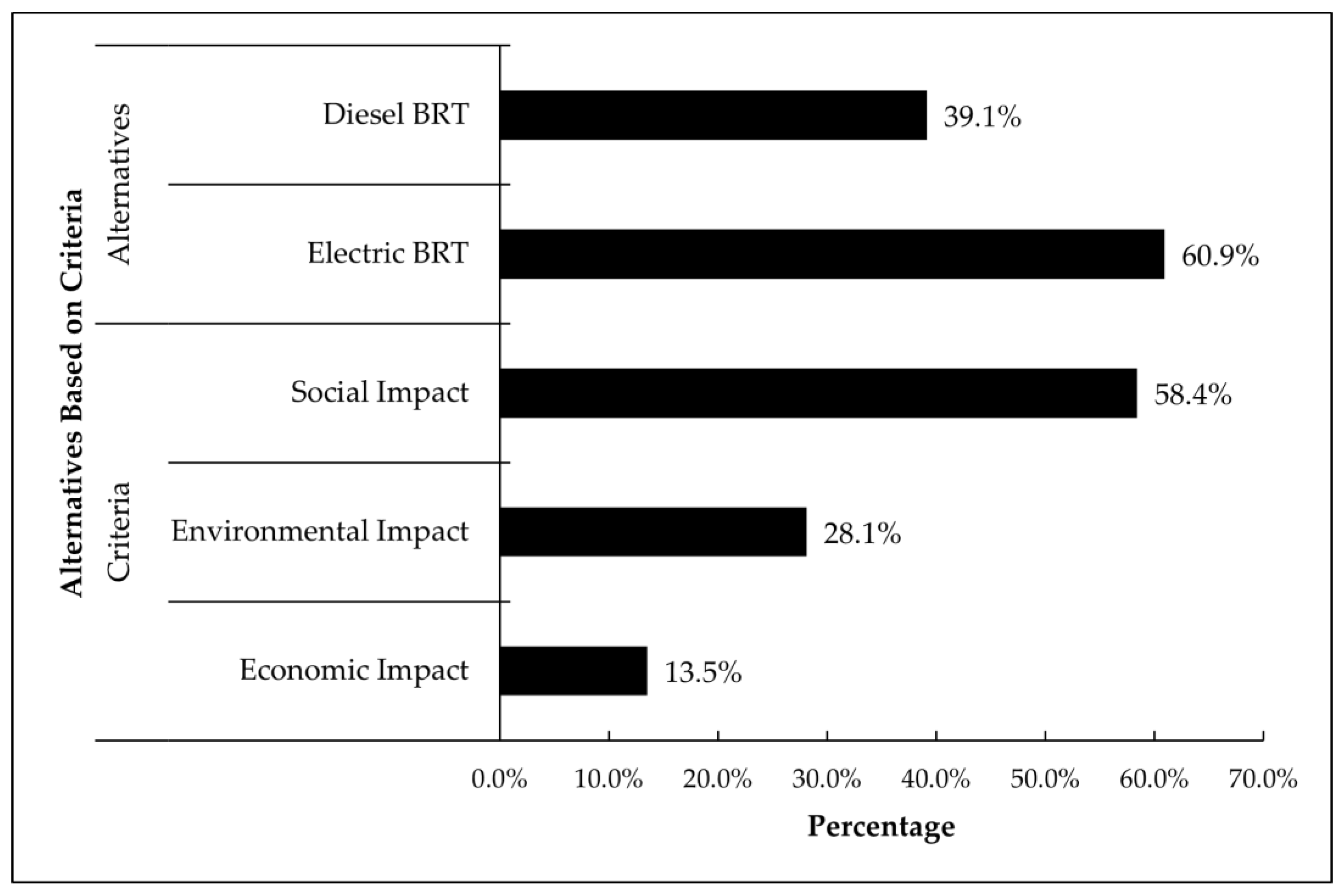
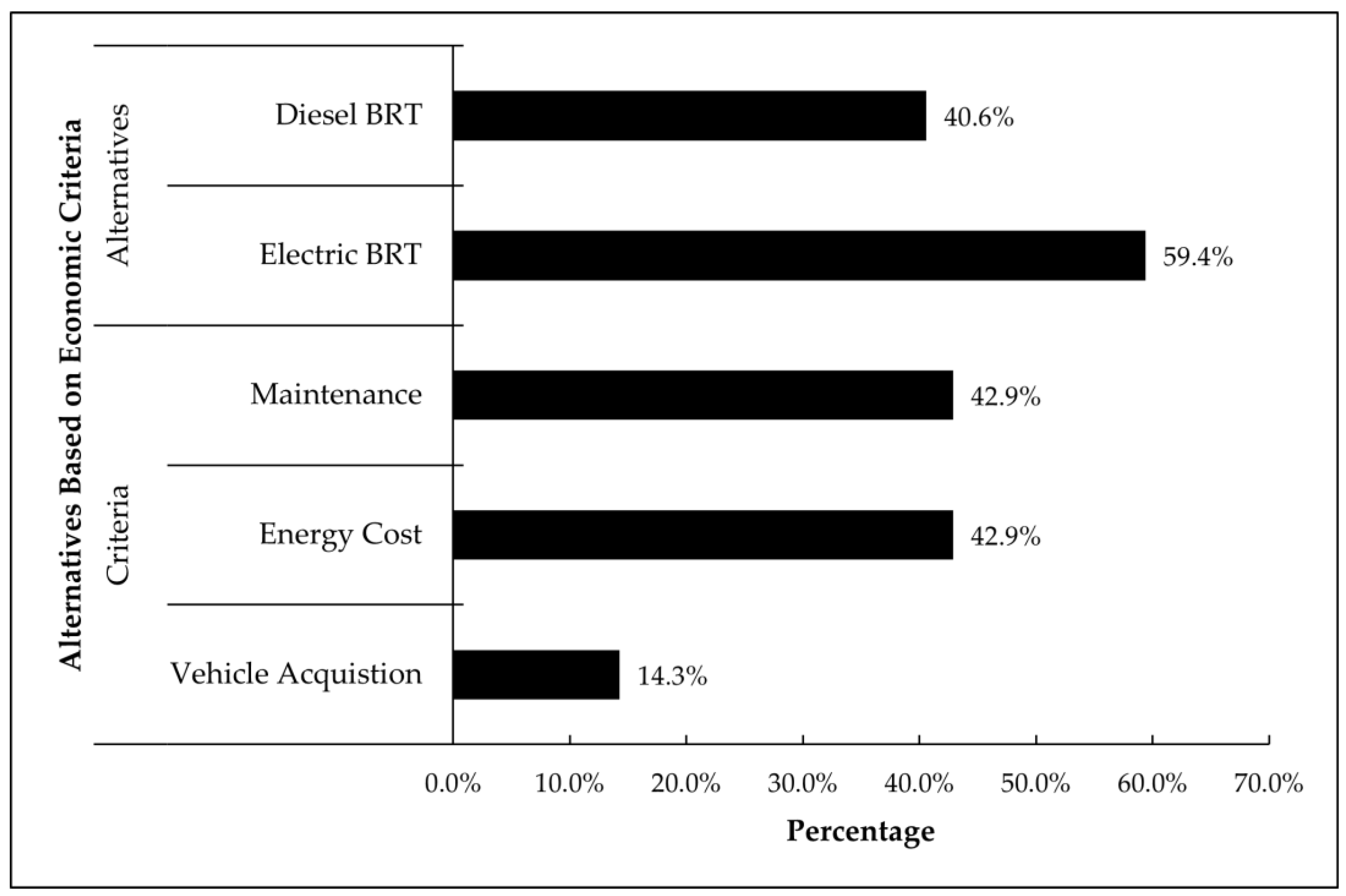

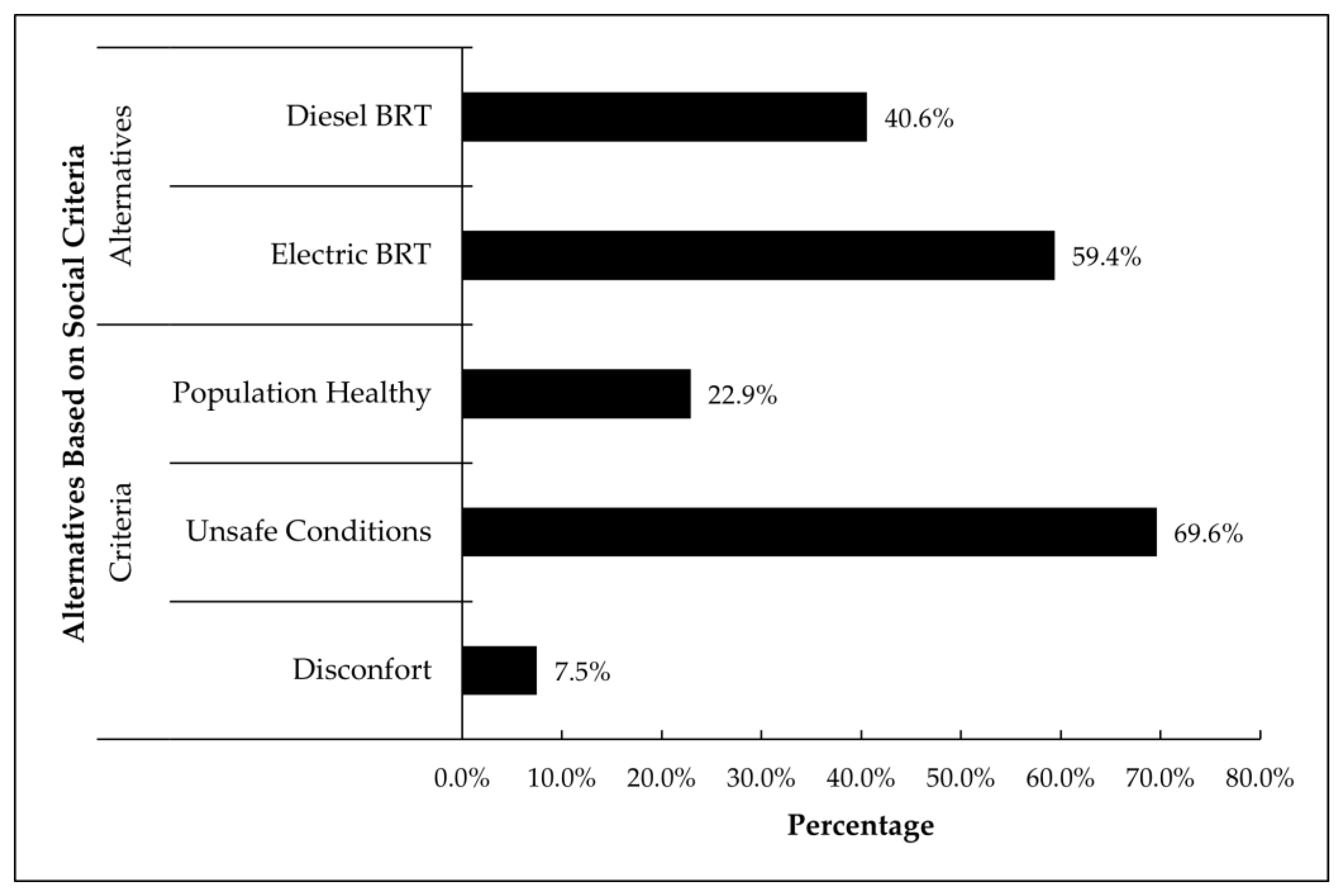
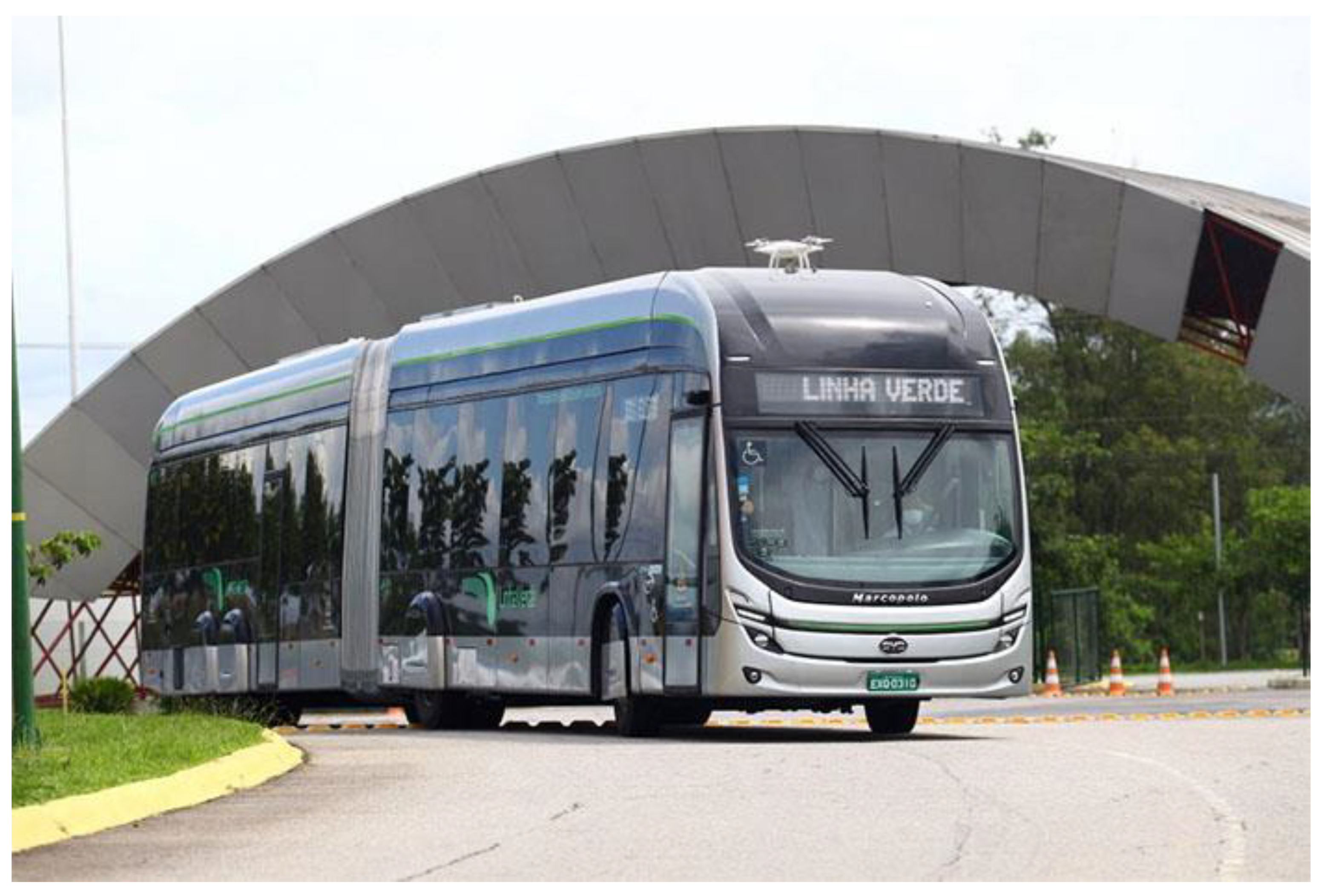
| Continent | Number of Cities | km | Passengers/Day |
|---|---|---|---|
| Africa | 6 | 152 | 491,578 |
| North America | 22 | 794 | 1,005,796 |
| Latin America | 63 | 2003 | 20,785,206 |
| Europe | 46 | 919 | 2,914,113 |
| Asia | 45 | 1691 | 9,238,060 |
| Oceania | 5 | 109 | 436,200 |
| Scale | Meaning |
|---|---|
| 1 | Equally Important |
| 3 | Moderate Importance |
| 5 | Strong Importance |
| 7 | Very Strong Importance |
| 9 | Extremely Important |
| 2–4–6–8 | Intermediate Values |
| Item | Battery Electric Bus (USD) | Diesel Bus (USD) |
|---|---|---|
| Vehicle acquisition per year | 46,000.00 | 36,000.00 |
| Energy cost per year | 19,000.00 | 98,500.00 |
| Maintenance per year | 104,500.00 | 105,600.00 |
| Total | 169,500.00 | 240,100.00 |
Disclaimer/Publisher’s Note: The statements, opinions and data contained in all publications are solely those of the individual author(s) and contributor(s) and not of MDPI and/or the editor(s). MDPI and/or the editor(s) disclaim responsibility for any injury to people or property resulting from any ideas, methods, instructions or products referred to in the content. |
© 2023 by the authors. Licensee MDPI, Basel, Switzerland. This article is an open access article distributed under the terms and conditions of the Creative Commons Attribution (CC BY) license (https://creativecommons.org/licenses/by/4.0/).
Share and Cite
Rodrigues, G.S.; Reis, J.G.M.d.; Orynycz, O.; Tucki, K.; Machado, S.T.; Raymundo, H. A Study on the Viability of Adopting Battery Electric Vehicles in Bus Rapid Transit in Brazil Using the AHP Method. Energies 2023, 16, 4858. https://doi.org/10.3390/en16134858
Rodrigues GS, Reis JGMd, Orynycz O, Tucki K, Machado ST, Raymundo H. A Study on the Viability of Adopting Battery Electric Vehicles in Bus Rapid Transit in Brazil Using the AHP Method. Energies. 2023; 16(13):4858. https://doi.org/10.3390/en16134858
Chicago/Turabian StyleRodrigues, Gabriel Santos, João Gilberto Mendes dos Reis, Olga Orynycz, Karol Tucki, Sivanilza Teixeira Machado, and Helcio Raymundo. 2023. "A Study on the Viability of Adopting Battery Electric Vehicles in Bus Rapid Transit in Brazil Using the AHP Method" Energies 16, no. 13: 4858. https://doi.org/10.3390/en16134858
APA StyleRodrigues, G. S., Reis, J. G. M. d., Orynycz, O., Tucki, K., Machado, S. T., & Raymundo, H. (2023). A Study on the Viability of Adopting Battery Electric Vehicles in Bus Rapid Transit in Brazil Using the AHP Method. Energies, 16(13), 4858. https://doi.org/10.3390/en16134858








